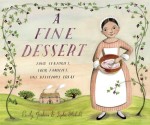Sugar-Coating Called Worse Than
No Representation At All
 Shortly after A Fine Dessert: Four Centuries, Four Families, One Delicious Treat (RH/Schwartz & Wade, Jan.) was selected as one of the ten Best Illustrated Book by the NYT Book Review, NPR’s Code Switch reported on the simmering controversy over the book’s portrayal of an enslaved mother and daughter in a story titled,”The Kids’ Book A Fine Dessert Has Award Buzz — And Charges Of Whitewashing Slavery.”
Shortly after A Fine Dessert: Four Centuries, Four Families, One Delicious Treat (RH/Schwartz & Wade, Jan.) was selected as one of the ten Best Illustrated Book by the NYT Book Review, NPR’s Code Switch reported on the simmering controversy over the book’s portrayal of an enslaved mother and daughter in a story titled,”The Kids’ Book A Fine Dessert Has Award Buzz — And Charges Of Whitewashing Slavery.”
The story comes full circle with an article in the New York Times, online Friday (in print on Saturday), “A Fine Dessert: Judging a Book by the Smile of a Slave.”
The book portrays history through the making of a single dessert, blackberry fool, in four different centuries, 1710, 1810, 1910, and 2010. The section from 1810 portrays an enslaved woman and her daughter making the dessert for a white family, then licking the remains from the bowl while hidden in a closet. Many objected that the mother and daughter appear to be enjoying the process of creating the fool, feeding the myth of the “happy slave” and that the closet scene, while stark in contrast, needs more context (see the NYT story for images of the pages).
The reactions have caused a soul-searching on the part of the books’ creators as well as at least one reviewer.
As the NYT notes, author Emily Jenkin has posted an apology online, saying that she will donate her writing fee to the campaign We Need Diverse Books.
Illustrator Sophie Blacknall, however, defends the book, as she did on Tuesday, responding to direct criticisms from author Daniel José Older at the Fall Conference of the New York City School Library System (section begins at time stamp 21:15).
The book received four starred reviews (the only holdout and the only prepub reviewer to raise a flag about the issue was Publishers Weekly). The Book Review Editor for School Library Journal, Kiera Parrott, wrote that publication’s starred review. She has posted comments on Twitter, and published them on Storify as “Reflecting on A Fine Dessert,” saying that at first she first felt the book’s depiction offered “a great opportunity to talk to [children] about America’s dark and painful history.” After reading what others have had to say, she says that she now realizes she was wrong and that, “It may feel odd for those of us who want to see more diversity to realize that sometimes NO representation is better than bad representation.”
For those who want to dive deeper into the issue, SLJ, has published a bibliography of discussion.
